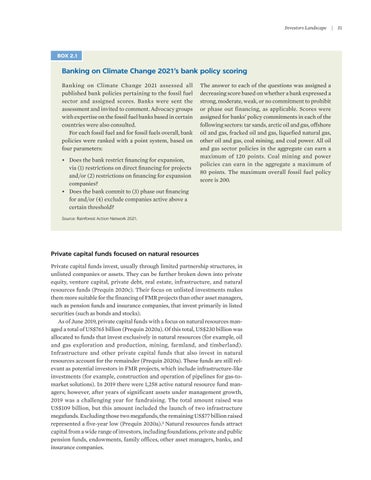Investors Landscape
BOX 2.1
Banking on Climate Change 2021’s bank policy scoring Banking on Climate Change 2021 assessed all published bank policies pertaining to the fossil fuel sector and assigned scores. Banks were sent the assessment and invited to comment. Advocacy groups with expertise on the fossil fuel banks based in certain countries were also consulted. For each fossil fuel and for fossil fuels overall, bank policies were ranked with a point system, based on four parameters: • Does the bank restrict financing for expansion, via (1) restrictions on direct financing for projects and/or (2) restrictions on financing for expansion companies? • Does the bank commit to (3) phase out financing for and/or (4) exclude companies active above a certain threshold?
The answer to each of the questions was assigned a decreasing score based on whether a bank expressed a strong, moderate, weak, or no commitment to prohibit or phase out financing, as applicable. Scores were assigned for banks’ policy commitments in each of the following sectors: tar sands, arctic oil and gas, offshore oil and gas, fracked oil and gas, liquefied natural gas, other oil and gas, coal mining, and coal power. All oil and gas sector policies in the aggregate can earn a maximum of 120 points. Coal mining and power policies can earn in the aggregate a maximum of 80 points. The maximum overall fossil fuel policy score is 200.
Source: Rainforest Action Network 2021.
Private capital funds focused on natural resources Private capital funds invest, usually through limited partnership structures, in unlisted companies or assets. They can be further broken down into private equity, venture capital, private debt, real estate, infrastructure, and natural resources funds (Prequin 2020c). Their focus on unlisted investments makes them more suitable for the financing of FMR projects than other asset managers, such as pension funds and insurance companies, that invest primarily in listed securities (such as bonds and stocks). As of June 2019, private capital funds with a focus on natural resources managed a total of US$765 billion (Prequin 2020a). Of this total, US$230 billion was allocated to funds that invest exclusively in natural resources (for example, oil and gas exploration and production, mining, farmland, and timberland). Infrastructure and other private capital funds that also invest in natural resources account for the remainder (Prequin 2020a). These funds are still relevant as potential investors in FMR projects, which include infrastructure-like investments (for example, construction and operation of pipelines for gas-tomarket solutions). In 2019 there were 1,258 active natural resource fund managers; however, after years of significant assets under management growth, 2019 was a challenging year for fundraising. The total amount raised was US$109 billion, but this amount included the launch of two infrastructure megafunds. Excluding those two megafunds, the remaining US$77 billion raised represented a five-year low (Prequin 2020a).3 Natural resources funds attract capital from a wide range of investors, including foundations, private and public pension funds, endowments, family offices, other asset managers, banks, and insurance companies.
|
31


